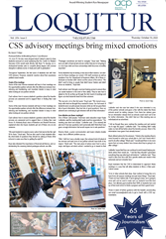 Emily Buerger
Emily BuergerWhile past female leaders paved the path for women to gain equality and leadership, today’s women are stepping up to fill the gap between men and women. Women worldwide are demanding equality and fulfilling leadership roles in the workplace and in academics.
Women have filled more than half of the United States jobs created in the first part of the decade and they have secured the most lucrative openings, according to the Wall Street Journal.
Overall, men gained 1,804,000 jobs and women 1,996,000, or 52.5 percent of the total increase, for the period studied.
Dr. Antoinette Iadarola, president of Cabrini College, said, “It was hard for women.”
While Iadarola and many other women have worked their way up into leadership positions, the 21st century has seen other female leaders bridge the gap between men and women. Condoleezza Rice made a leap for women when she was appointed as the first female African- American to be the secretary of state in 2005. In 2007, another step for women was taken as Nancy Pelosi became the first woman speaker of the House. Also, Hillary Rodham Clinton is trying to help break the nation’s highest glass ceiling by becoming the first female president for the 2008 presidential election, according to the Washington Post.”
Beth Briggs, a freshman psychology and sociology major, said, “We’re past due for a female running.
Iadarola sided with Briggs as she said, “It’s a travesty we even have to say that. I’d like to see more women in political life.
Like many other women, Iadarola had to work her way to the top. She recalled a time when she had written an article at Oxford University and it had gone to the public for critiquing. Iadarola was told by her mentor not to publish her first name since women had difficulty establishing their names. At the time, men were the only people considered to have writing that was worthy for the public. After Iadarola’s article made it to the public, many informed her mentor that the man who wrote the article did credible work. The critiques were favorable. After the public accepted Iadarola’s piece, her first name was released.
Iadarola said, “It was hard for women to be taken seriously.”
Women have also been taking the lead in the academic field as well. According to the U.S. Census Bureau, 870,000 bachelor’s degrees will be awarded to women in the 2006-2007 school year. Women also are expected to earn 369,000 master’s degrees during this period. Women would, therefore, earn 58 percent of the bachelor’s and 61 percent of the master’s degrees awarded during this school year. Also, there are 26.1 million women 25 or older with a bachelor’s degree or more education in 2005, more than double the number 20 years earlier.
Mary Krystyne Burgess, a junior psychology major, said, “I think it’s a really great step for women. It makes me proud to be a woman.”
Iadarola also explained that to be a successful leader several qualities are necessary. She described a leader as needing to have persistence, self-confidence, perseverance, competence and a sense of humor. These qualities are needed in both men and women. Iadarola also said that taking risks is an important part of being a leader.
Briggs said, “There’s still a glass ceiling but it’s not as severe.”
Today, 37 percent of women 16 or older work in management, professional and related occupations, compared with 31 percent of men, according to the U.S. Census Bureau. Also, as of 2005, only eight Fortune 500 companies have women CEOs or presidents. In 1995, 8.7 percent of corporate officers in Fortune 500 companies were women. This percentage rose to 16.4 percent by 2005.
Iadarola said, “The future belongs to those who believe in their dreams.”


